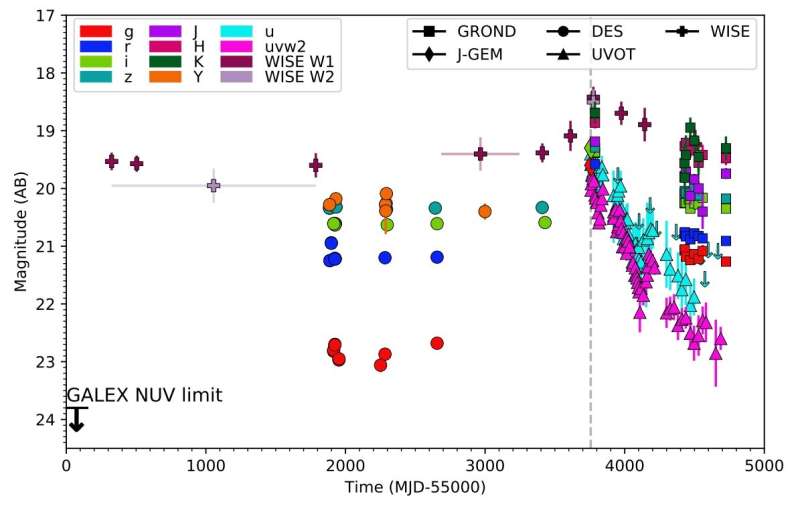July 14, 2023 report
This article has been reviewed according to Science X's editorial process and policies. Editors have highlighted the following attributes while ensuring the content's credibility:
fact-checked
preprint
trusted source
proofread
Astronomers discover a luminous nuclear transient

Using NASA's Swift spacecraft, an international team of astronomers has discovered a luminous and slowly-evolving nuclear transient event. The origin of the newly detected transient, designated Swift J221951-484240, is yet to be determined. The finding was reported July 3 on the preprint server arXiv.
Nuclear astrophysics is key to understanding supernova explosions, and in particular the synthesis of the chemical elements that evolved after the Big Bang. Therefore, detecting and investigating nuclear transient events could be essential in order to advance our knowledge in this field.
Recently, a group of astronomers led by Sam Oates of the University of Birmingham, U.K., has conducted follow-up Swift observations of a gravitational wave alert known as S190930t in order to find its electromagnetic counterpart. In result, they identified Swift J221951-484240 (or J221951 for short) with Swift's Ultra-Violet/Optical Telescope (UVOT).
"J221951 was discovered during the follow-up of a gravitational event: S190930t.... The source appears nuclear when comparing our ACS [Hubble Space Telescope's Advanced Camera for Surveys] imagery to DES [Dark Energy Survey] images going back to 2014," the researchers explained.
J221951 was found at a spectroscopic redshift of 0.52, which rules out its association with S190930t. At peak, J221951 was brighter than archival values at all ultraviolet, optical and infrared wavelengths, by more than 1–3 magnitudes. The transient reached a peak absolute magnitude of -23 mag and a peak bolometric luminosity of 1.1 quattuordecillion erg/s.
The total radiated energy from J221951 was estimated to be about 26 sexdecillion erg. According to the astronomers, this result, together with the lack of broad absorption lines in the optical spectrum, rules out the supernova explosion scenario for J221951.
Archival photometric data for J221951 show a slow rise prior to a peak near the discovery date. Moreover, the new optical spectra of this transient are blue and relatively featureless. Therefore, based on all the results, Oates' team has classified J221951 as a luminous and slow-evolving blue transient.
Trying to determine the origin of J221951, the authors of the paper take into account two most plausible hypotheses as the transient has properties consistent with a tidal disruption event (TDE) and the turn-on of an active galactic nucleus (AGN).
"The progenitor of J221951 is unclear. The optical and ultraviolet spectra show features resembling both TDEs and AGN. Overall its spectral, temporal and host properties and its energetics are closest in nature to ASASSN-15lh and ASASSN-18jd. ASASSN-15lh, ASASSN-18jd and J221951 belong to an increasing population of luminous blue transients, dubbed ambiguous nuclear transients for which the progenitors are not well constrained, but may be TDEs or due to AGN activity," the researchers explained.
They added that further observations of the late time evolution of J221951 will be crucial in order to find out which hypothesis is true.
More information: S. R. Oates et al, Swift/UVOT discovery of Swift J221951-484240: a UV luminous ambiguous nuclear transient, arXiv (2023). DOI: 10.48550/arxiv.2307.01044
Journal information: arXiv
© 2023 Science X Network



















